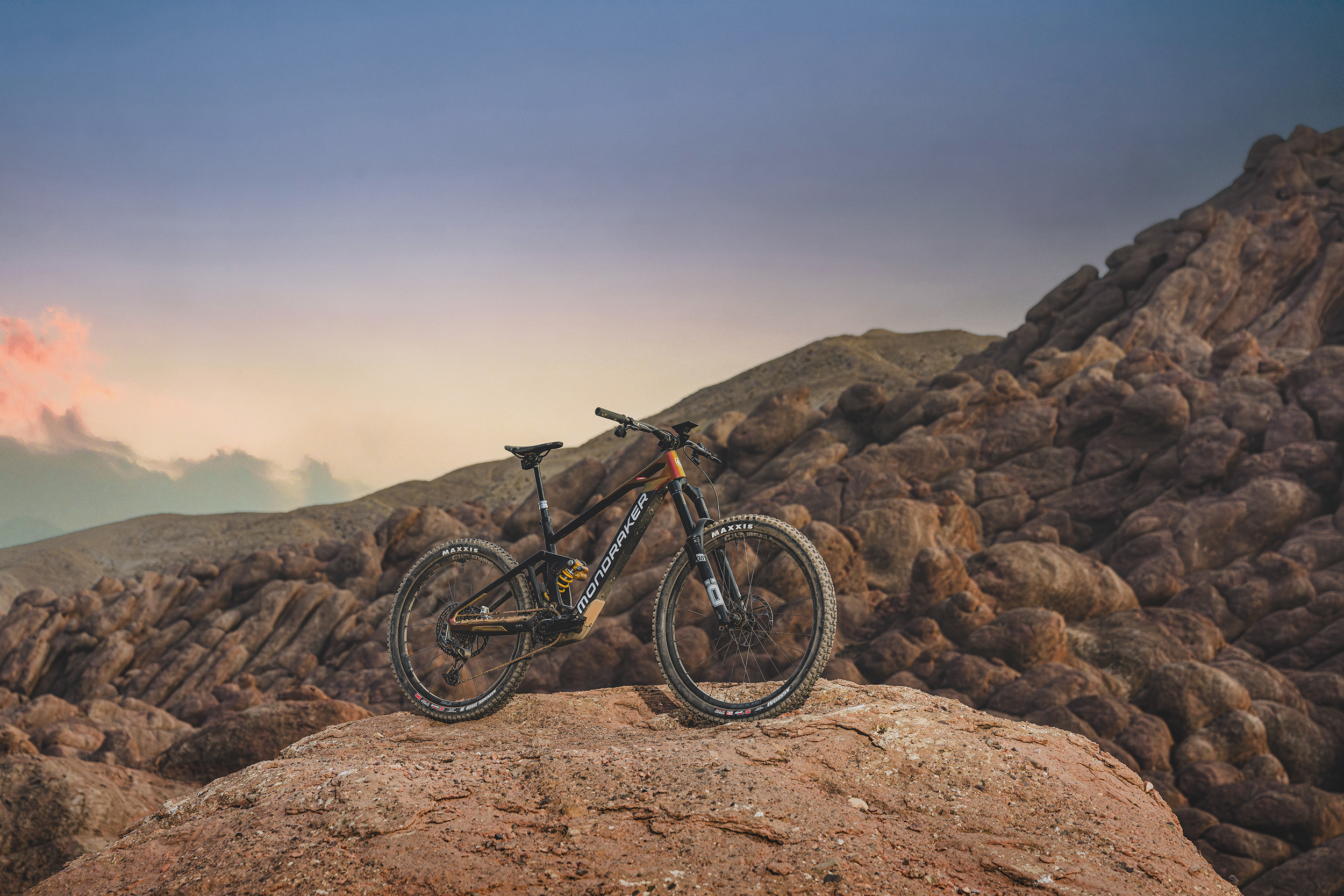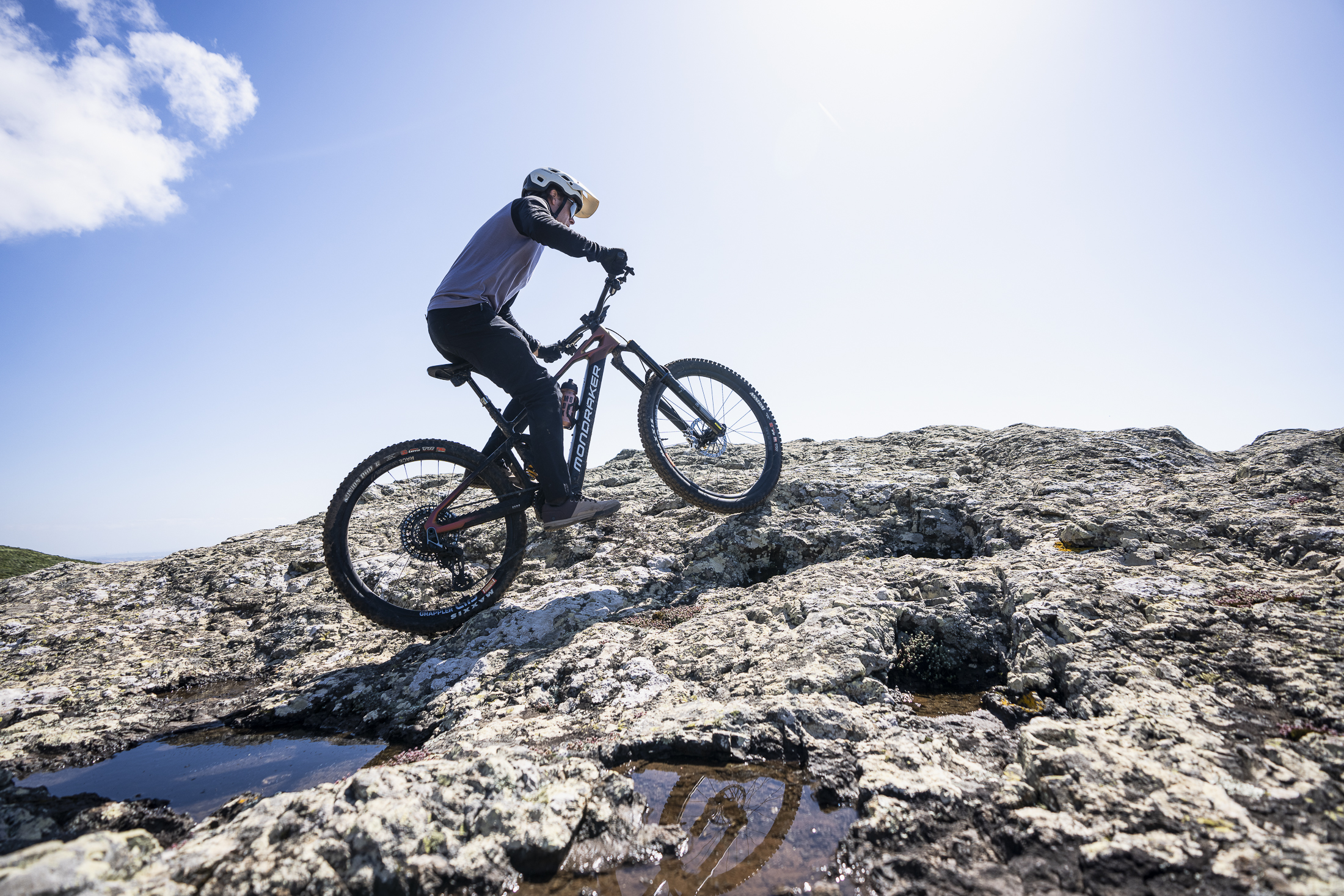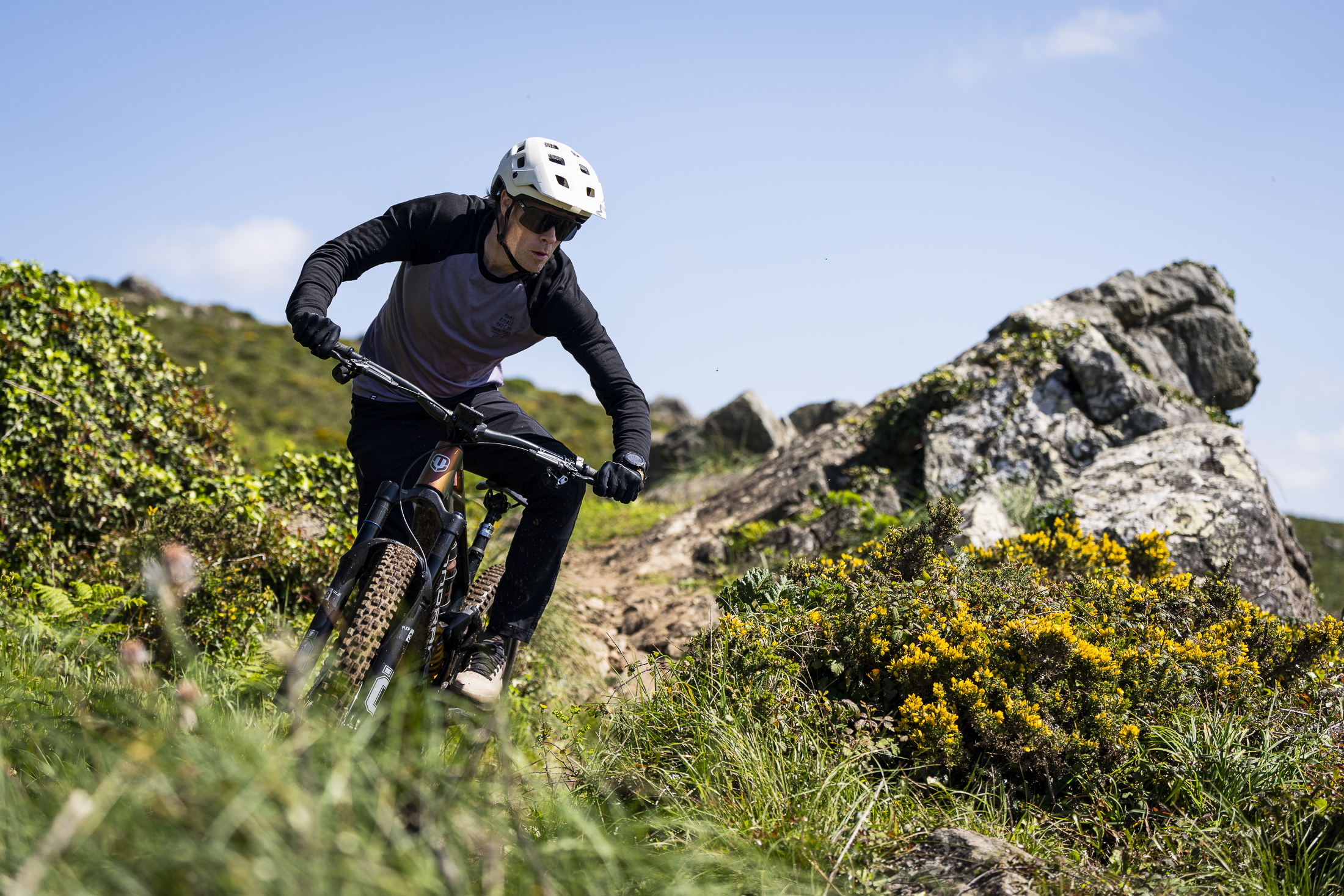Mondraker's Dune is billed as a natural evolution of enduro for the Spanish brand; a long-travel SL eMTB boasting aggressive geometry, capable componentry, and a potent motor in the form of Bosch's latest Performance SX. Sprung with Ohlins’ 165mm coil shock and 180 mm fork, Dune XR is poised to lay ruin to technical descents. Did Mondraker’s plans for domination translate to real-world performance on trail? We went halfway around the world to find out.
Highlights
- Stealth Air Carbon frame (Mondraker's highest-end carbon option)
- Mixed wheels only
- 165mm of rear wheel travel // 170mm fork (180mm fork on XR model)
- Zero suspension design
- 55Nm Bosch Performance SX motor with 600W of peak power
- 400Wh Integrated Battery (water bottle mounted 250Wh range extender available separately)
- Top tube integrated Bosch Performance SX System controller
- Handlebar-mounted Bosch Kiox 500 display and Mini Remote
- 64 º head tube angle (RR/R models) // 63.6º head tube angle (XR model)
- 77.1º effective seat tube angle
- 445mm chain stay length
- UDH compatible
- Internal headset routed cables
- Sizes: S-XL
- Claimed weight (size M): R build - 44.5 lb // RR build - 42.8 lb // XR build - 43.2 lb
- MSRP: R build- $7,999 // RR build-$9,299 // XR build- $11,999
Strengths | Weaknesses |
|
|

Dune Overview
The Dune model dates back to 2009 when it launched as Mondraker's flagship enduro bike. It was also the first bike to use their now iconic Zero Suspension design. After a brief hiatus from 2020 to now, Dune returns as a 165mm travel, modern enduro bike with the ability to reach the top of the climbs via e-assist. This is not Mondraker's first SL eMTB—the NEAT satisfies the trail/all-mountain category with 150mm of travel and a competitive X-weight. With Dune, Mondraker wanted to give riders a long travel platform with limitless descending abilities and were okay with striking a slightly heavier weight to do so. It's still lighter than a full-size e-bike, but it is on the heftier side when compared to most 'SL' eMTB.
The new Dune borrows design cues from the Superfoxy "superenduro" mountain bike, albeit with a modernized approach to geometry and suspension design. Esthetically, Dune follows Mondraker's latest design language of angular, clean lines, which was first used with the Neat SL.

Dune's carbon frame features Stealth Air Carbon— Mondraker's lightest and most compliant carbon layup— with the main triangle weighing just 2,650 grams. The frame integrates a carbon fiber rocker linkage, motor bash guard, shock mudguard, and molded frame guards along the rear triangle. There are mounts under the top tube for accessory storage, and a downtube bottle cage mount doubles as a holster for the optional range extender.
Bosch Performance SX Motor Details
The heart of Dune is the 55Nm Bosch Performance SX motor, Bosch's answer to the growing SL eMTB category. Churning out 600W of peak power and a maximum support level of 340%, the SX motor features four modes with tunable power settings: Eco, Tour, eMTB, and Turbo. Of course, each can be individually adjusted in the eBike Flow app.

A 400Wh battery is integrated into the frame, weighing 2,070 grams. Bosch's PowerMore 250Wh range extender is an optional add-on, providing an additional 60% range.

A handlebar-mounted Mini remote is used to toggle between the motor's assist modes, while an optional Kiox 500 display mounted at the center of the cockpit shows real-time ride data, including power, cadence, speed, and battery level. Integrated into the top tube, Bosch's System Controller features the motor's power button, a second means to select the assist mode, and an LED indicator signifying battery charge level.

Visually, the SX motor is less discrete than its competitors, and there's no faking that Dune is an eMTB.
Geometry
Dune uses Mondraker's signature Forward Geometry formula of longer reaches combined with a short stem for increased stability and control. Over time, the industry has caught up to Mondraker's approach to reach and body positioning. The 460mm reach and 30mm stem on our size medium test bike with a 180mm fork was not out of "reach" per se from the rest of the industry. The 170mm fork on the RR and R models extends reach by another 5mm, but compared to other brands, Dune is by no means pushing the limits of frame size too far.

Dune's head angle sits at a comfortable 64 º for the RR and R models paired with a 170mm fork and 63.6 º for the XR model with a 180mm fork. Stack heights are nice and tall across all sizes to match the descending personality of Dune, and all sizes also use a 445mm chainstay length with mixed wheels.
Suspension Design
Dune utilizes a revised iteration of Mondraker's proprietary Zero Suspension design. A virtual pivot system with an exclusive dual-link design, the shock floats between the two links, compressing at both ends. Dune's updated suspension design allows the shock to rest lower in the frame, increasing the initial sensitivity while also being capable of absorbing large hits. The lower shock placement also allowed Mondrkaer to make the swingarm more compact, increasing stiffness and reducing frame weight.

Build Kits
Dune is available in three build kits, the XR model that we tested, the RR, and R. The premium $11,999 XR build features Ohlins suspension, an RXF 38 M.2 180mm fork paired with a TTX22M.2 coil shock, SRAM X0 Transmission, E.13 TRS Race carbon cranks, SRAM Code Ultimate Stealth brakes, a RockShox Reverb AXS dropper, and e*thirteen Grappler Race Carbon wheels.
The $9,299 RR build also utilizes Ohlins suspension but with an air shock and foregoes the carbon wheels and crankset, while the $7,999 R build features a FOX Float X Grip Performance shock and a 38 Performance fork. All builds use the same Maxxis tires (DoubleDown casing rear, EXO+ front), 4-piston brakes with 200mm rotors F/R, and Mondraker's house brand OnOff bars and stems.
Mondraker recently joined the growing array of European manufacturers offering a long-travel SL eMTB in the North American market. With a U.S. headquarters in Boulder, Colorado, Dune models are expected to be available by late May.
On The Trail
To debut the new Dune, Mondraker invited us to the appropriately sandy beaches on the planet Arrakis. Err, wrong Dune, the town of Sintra, Portugal. Sintra's unique Atlantic coastline contrasts dry, desert-like terrain on the south end of the mountain with a lush, green forest canopy on the north side.

Our testing encompassed two full days, climbing 15,000 feet of vert across 70 miles on the XR model. Blessed with ideal trail conditions from recent early spring rains, it was immediately clear why Mondraker chose the coastal sandy landscape and dense forest for the test location. Sintra's flowy singletrack trail network is littered with technical rock features, small jumps, drops, and snappy turns. Our European colleagues tout it as a favorite trail destination that you definitely should not visit.
Bosch Performance SX Performance
The Bosch Performance SX motor was a highlight of the Dune. A relatively new motor in the SL category, its power delivery feels similar to its bigger brother, the full-power CX system. Getting acquainted with the power delivery of the SX motor took no time whatsoever. While most SL motors tend to harshly jolt in and out of assistance as pedal cadence changes, the SX could not be more opposite. Imitating the feel of a full-power eMTB, the SX provides consistent power, increasing output as the rider pedals harder. With less torque, there is less overrun when the pedaling halts compared to a full-power system.
In terms of smoothness and natural "feel," the SX motor was reminiscent of SRAM's full-power Powertrain that we enjoyed testing last fall. Even the power delivery hits stronger than the 55Nm of torque suggests, noticeably more powerful than other SL motors in its class, such as the Fazua or TQ. That power comes with a consequence, however: a noticeable strain on battery life.
3,500 feet of elevation gain seemed to be the red line for the 400Wh battery, with some editors expiring the battery sooner. Granted, much of our climbing occurred on fire roads in the Tour+ or eMTB modes. Utilizing Eco could squeak out a slight amount of additional battery life.

One critique of the system is that the Bosch remote button could benefit from more resistance when selecting assist modes. It's all too easy to mistakenly graze the button when riding, changing the mode unintentionally. The optional Kiox 500 display also adds clutter to the cockpit and can be distracting at first, but it is convenient for confirming the assist mode. Foregoing the display would suit most riders, as the System Controller integrated into the top tube displays all necessary mid-ride stats.
Climbing Performance
Despite clocking 15,000 feet of vert across our two-day test, our climbing experience was mostly relegated to fire roads with limited uphill miles on technical singletrack. When we encountered short steeps or loose rock, the Dune handled them with stride; the SX motor delivered an appropriate amount of power to complement our cadence. Even with the strong power delivery, we did not experience any unexpected surges of power, causing us to break focus or inadvertently veer off line.

The motor's noise remained nearly undetectable during climbing, even in Turbo, although we noticed several other editor's motors increasing in pitch throughout the day. The 165mm crankarm length was appreciated on our size medium, with no frustrating rock strikes experienced. Larger sizes receive a 170mm crank arm length. The size medium's 460mm reach with a short 30mm stem offered a comfortable setup that felt natural from the get-go, allowing for plenty of range of motion to manipulate the bike when necessary. As is typical of long travel bikes, the bike's seated climbing position is relaxed, resulting in the need for the rider to pivot weight forward on steeper pitches.
Descending Performance
With its 165mm of rear wheel travel tied to a coil shock and paired to a 180mm fork, the Dune XR begged to be ridden with the brakes off, attacking technical chunk. The Ohlins TTX22M.2 rear shock makes quick work of trail chatter, keeping the bike planted and predictable, even when line choice was less than desirable. The only shock setting we mingled with throughout the test period was the high-speed compression, which was tunable via a lever with three positions. Mondraker recommended the middle setting, and we toggled back and forth between fully open and middle depending on whether big hits or small bump chatter were the prevailing trail condition.

The Ohlins RXF38 M.2 fork required additional setup time compared to a FOX or RockShox fork. The Ohlins fork uses a positive main chamber and a self-equalizing negative chamber, with a third chamber called Ramp Up for mid-stroke and bottom-out support. Finding the right balance between the main air chamber and the Ramp Up takes some experimenting, but even if you're off your mark (as we found out during the first ride), it's not a deal breaker. Just take the time to arrive at a proper setup to make sure you get the most out of the fork and bike. Mondraker uses a custom tune on the Ohlins suspension package for Dune. The stock damping on aftermarket Ohlins products leans to the heavier side, but Mondraker decided to use a lighter tune. We are curious how the stock tune would feel, as we settled on main chamber and Ramp Up pressure settings that were a bit higher than what the factory chart recommended.

The Dune XR's slack 63.6 head angle and 1,260mm wheelbase made it a competent descender when the trail opened up. Our favorite Sintra trail, the double black diamond Kamikaze, contained numerous sections with repetitive hits, drops, and small gaps that required letting off the brakes and letting the bike do its thing. This is where we found Dune to be most rewarding. It begged to be pushed faster and ate up anything in its path.

Dune's personality leans to more of a point-and-shoot rig rather than an all-out playful ride, which is less than surprising given its "superenduro" intention. The 27.5-inch rear wheel did improve the bike's maneuverability through sharper corners, but it still required quite a bit of input. The rear also lacked traction when navigating greasy pitches, causing unwanted fishtailing under braking. The Maxxis Minion's firmer MaxxTerra compound likely played some part in that less-than-controlled feel, but we were left curious how a 29-inch wheel would have felt in those scenarios.
Things That Could Be Improved?
Overall, the Dune XR has a commendable spec, minus the Fizik Terra Aidon saddle, which more than a few riders in the group complained about its lack of comfort. Mondraker's in-house OnOff grips fall into a similar category with an incredibly firm compound that was harsh on our hands, making it hard to hold on to the bars as the miles ticked on. We would have preferred the OnOff grips simply be "off" the bike.

What's The Bottom Line?
Dune feels at home under a rider who can push the limits on fast, technically demanding descents. The bike comes to life when the brakes come off — an epic weapon for tackling rocky terrain and blistering fast descents.
It is not the most agile or playful lightweight e-bike on the market. Dune requires extra effort to maneuver through tight sections or to get the tires off the ground. At 43+ pounds, it won't be in the running for the lightest eMTB, but it is refreshing that Mondraker selected an all-around enduro-worthy component package. Despite taking a toll on the 400Wh battery, Bosch's Performance SX motor enriches the riding experience with its consistent power output, nearly bridging the gap between an SL and a full-power motor.
Dune is a big-hitting, long-travel rig aimed at riders who possess the skills for fast, technical enduro terrain and want the ability to self-shuttle. It's a capable contender where the trail demands an aggressive bike that will confidently remain planted and predictable in its line.
For more information, please visit mondraker.com
View key specs, compare e-bikes, and rate the new Mondraker Dune in the Vital MTB Product Guide.
About The Tester
Rick Reed - Age: 41 // Years Riding MTB: Who's counting? // Height: 5' 9" (1.75m) // Weight: 142 pounds (64.4kg)
A veteran of the bike industry, Rick "E" Reed is a regular contributor to Vital. Rick enjoys riding fast tech, backcountry singletrack, and bike parks, occasionally sharing his chocolate with a select human being or two (you know who you are). He resides in Reno, Nevada, with his terror dog, Zuul.













View replies to: FIRST RIDE - Mondraker's DUNE Returns as a Lightweight Enduro eMTB
Comments